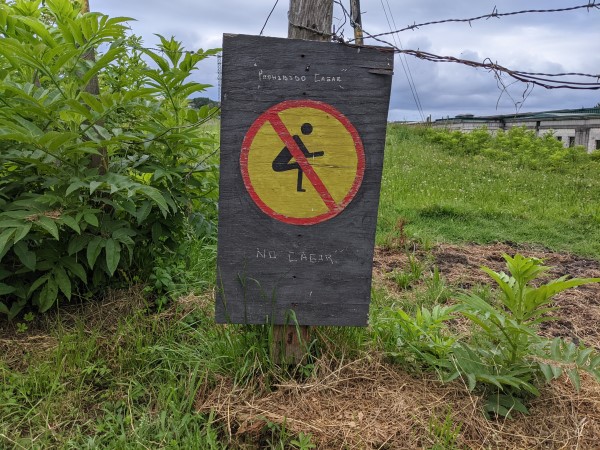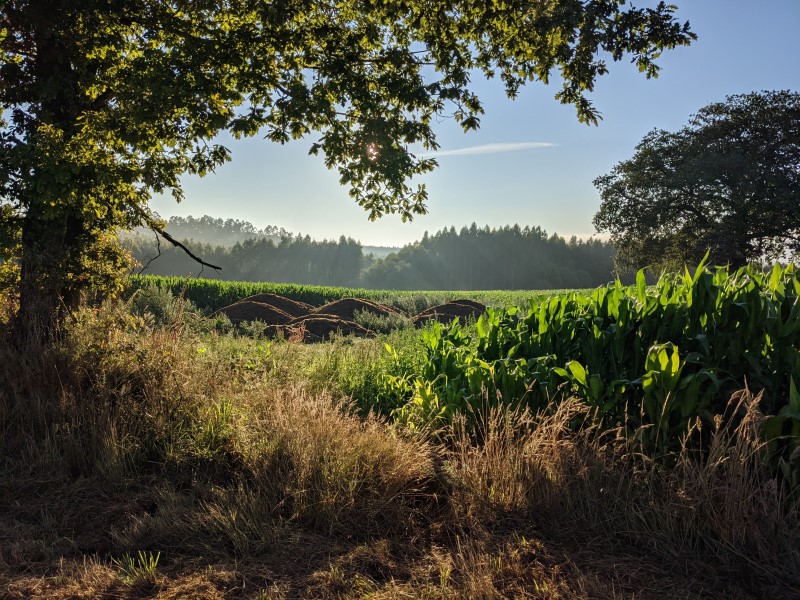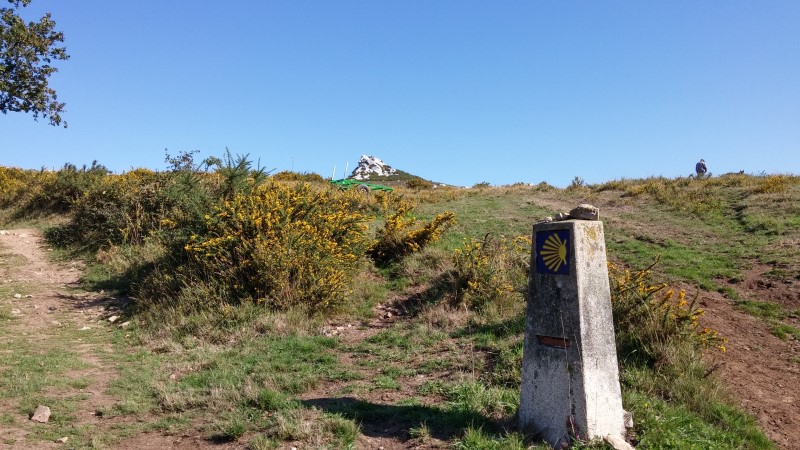Camino de Santiago is not a walk in a jungle, or in a thick forest where every tree fifty feet away from the trail offers an opportunity to relieve yourself in privacy. On the contrary, you will walk a lot in open spaces, in the fields and on the plains of inland Spain (super beautiful by the way). What’s more, regardless of whether you follow the most popular French Camino, or opt for one of the alternatives (Portuguese, Norte, Via de la Plata, etc), a lot of road walking also forms a part of experience. (Do not be worried though, with a few exceptions these are small country roads with almost no traffic.)
What I try to say here is that you just cannot go to toilet anywhere on the Camino, as some people may envision when seeing pictures or some movie from the way. Sure, on some Caminos it is easier to find a fitting spot than on other ways (more to this later on), but in many cases you need a physical toilet, that means a place that is intended as a toilet, and many “Camino newbies” wonder if they can find enough toilets on the way. At the end of the day you want to enjoy your walk, instead of constantly thinking about the next place to stop for a bathroom break, and whether you’ll manage to reach it without wetting your pants. So, are there toilets on Camino de Santiago, and how many of them?
Table of Contents
There are no portable toilets on Camino de Santiago
If you envisioned typical portable toilets placed along the way, for example on every mile, to make sure the pilgrims have enough options to relieve themselves whenever they need, I have to disappoint you. There are no portable toilets on the Camino, and if the urge to go is stronger than you, and you happen to face this urge in the middle of nowhere (for example while crossing a long vineyard or cornfield), you’ll have to improvise and “go into the bushes”.
I can assure you that locals do not like such a practice, and you will find many funny signs along the Caminos in Spain, warning pilgrims not to relieve themselves on the trail or in close proximity. Yet we are people and have needs, and sometimes we just cannot help it. Therefore on virtually every “hidden spot’ in a relatively open country on a Camino, you’ll find some “brown surprise“, or at least some napkins indicating that someone already had the same idea as you do. It isn’t something pilgrims like to talk about, but in my opinion also this is the Camino…

– I think the sign doesn’t really need further explanations :). You can see this one during your first week on Camino del Norte. Sure enough when I was there one pilgrim found it provocative and went to defecate right behind the fence…
Toilets in bars and infrastructure along the way
The lack of portable toilets and bushes along the Camino does not mean that you’ll have to hold it for hours though. Camino is a unique concept in many ways, and one of them is the abundant infrastructure. If I exaggerate a bit, you can find a bar or a cafeteria on almost every second kilometer on the Camino Frances.
And it may not surprise you that many pilgrims stop there primarily for toilet, even though they buy coffee and whatever. I actually find it a funny circle, since coffee makes you want to pee or wee, and hence in an hour you need to stop in another bar, for another coffee, and so on :). Luckily for coffee lovers (and toilet seekers) bars and other places with toilets are pretty abundant on the major caminos.
When it comes to cleanliness of the toilets though, in my experience it is a bit of hit and miss. In the albergues (pilgrim hostels) toilets are almost always spotlessly clean, but in the bars I’ve experienced a variety ranging from “golden faucets” to “shit on the ground”. However, with recent booms of online reviews (and how everyone checks them), many places pay more attention nowadays, and staff checks the toilets every hour, making sure there isn’t any nasty surprise waiting for a pilgrim.
* May also interest you: Camino de Santiago ultralight packing list, 2023 edition.
Do you have to pay for the toilets on the Camino?
Maybe you do not want to stop in a bar. You just want to use toilet and keep walking. On Camino Frances, if you walk in the main season, this should not be an issue. There are typically many pilgrims in each bar, and while some are drinking something others will just use the toilet. The owner can hardly notice (being busy with serving the customers), and in most cases they likely won’t care anyway, knowing that some of your fellow pilgrims are actually spending money in the place.
Having said that, the closer you get to Santiago (think the last 100 kilometers from Sarria for example), the more difficult it gets. In these places toilets are often locked by the key that you have to ask from the staff, and often there is a flat fee (50 cents, 1 euro) for using a toilet only (if you buy something you do not have to pay the fee). Once I was lucky to witness how lucrative a business this can be, when a big group of about 30 people stopped in a bar where I had an orange juice, and almost all of them only used the toilet (paying 50 cents each for the visit).


– Endless fields of Via de la Plata (Seville – Santiago). Beautiful for the eye, but hard to find a good spot for the toilet…
Situation with toilets on different Caminos in Spain
I wrote this many times on this website, but no two Caminos are equal, and it definitely applies also to the availability of toilets, and the frequency with which you can encounter them along the way. As a rule of a thumb, the more popular the Camino, the more toilets you will encounter along the way in the many bars and coffee places. On the other hand, the popularity of the trail and the number of pilgrims may make it sometimes hard to find a fitting spot to relieve yourself “in the nature”, should you want or need to do so.
The supply always follow the demand, and hence it cannot surprise you that the less-trodden the way, the harder you will find it to encounter a public space with a toilet. Having said that, unless you are scared of ticks or simply of pulling your trousers down in the nature, you won’t find it that hard to locate a fitting spot for relieving yourself on less popular Caminos. Less people means less competition for such spots :). And also less eyes that can spot you while doing your thing. Having said that, each Camino has some specifics when it comes to toilets, and I will try to outline it briefly now.
Specifics of toilets (both regular and in the nature) on various Caminos
- Camino Frances: Lot of toilets in bars and cafeterias along the way, no need to worry, though make sure you have a piece of toilet paper with you.
- Camino del Norte: Infrastructure is pretty good as well, but some long stretches of road walking and beach walking are present, and in some sections it is quite hard to find a fitting spot to relieve yourself.
- Via de la Plata: Long stretches without infrastructure, open fields and vineyards often stretching for miles on end. Probably the worst Camino for someone who is super shy, or needs toilet often. On many stages it is really hard to find a good spot and you will have to “hold it” until the next town.
- Camino Portuguese: Good infrastructure and also many fitting spots for “leaving your temporary mark” in the nature around the trail.
- Camino Primitivo: Not as good as it seems, considering they call it mountainous Camino. Sure, there are many mountains, but often with no trees. On the contrary, the roads are surrounded by bushes with sharp thorns that can make for a pretty unpleasant toilet experience. This Camino is growing in popularity though, and hence each year new bars and other places with toilets open their doors for pilgrims.
- Olvidado, Lebaniego, San Salvador: Infrastructure is lacking, but these Caminos are mountainous and few pilgrims walk them. Hence you shouldn’t find it difficult just stopping for toilet almost anywhere on the trail.
- Ingles, Invierno, Mozarabe: Sufficient infrastructure considering the little number of pilgrims. They do not have that many good spots for relieving yourself when compared to the three ways above, but on the other hand (with exception of Mozarabe) you have more bars and cafeterias.
Final thoughts
Whether we like it or not, going to toilet is a part of our life. It is completely understandable that you may have some worries, especially if you have bladder problems or hate going to toilet in the nature. Camino is a long walk, and regardless of how well the infrastructure is developed, you may find stretches without bars and cafeterias.
Having said that, hundreds of thousands of people of all ages walk the Camino each year. Sure, maybe you’ll have to step out of your comfort zone and go to a toilet on a place you do not like once or twice during the Camino, but in my book that’s part of the experience, and nothing that should discourage you from walking the way. I hope this post shed some light on the issue of toilets on the different Caminos, and that it did not discourage you from embarking on your pilgrimage :). Buen Camino!
Matej
May also interest you:


![Ultralight Packing List for Camino de Santiago [2024 Edition]](https://caminolovers.com/wp-content/uploads/2022/03/altra-shoes-640-x-480.jpg)



